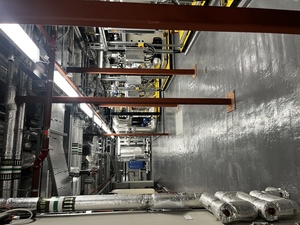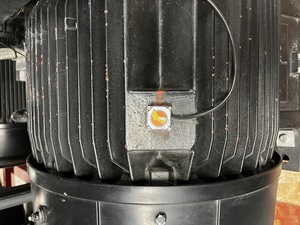
 |
Charlotte Stonestreet
Managing Editor |
| Home> | AUTOMATION | >Condition Monitoring | >Cutting edge monitoring |
Editor's Pick
Cutting edge monitoring
16 December 2024
We are all familiar with the imposing sight of the numerous skyscrapers that make up the London skyline, but have you ever thought about what goes on behind the scenes daily to keep things running smoothly? Charlotte Stonestreet visited the Scalpel to find out more

LOOKING AROUND 52 Lime Street, otherwise known as the Scalpel, I can't help but think of the quote from modernist architect Le Corbusier that a house is a “machine for living in”. Of course Le Corbusier was talking about domestic rather than commercial buildings; nevertheless behind the scenes at the Scalpel, the idea of a building having machine-like qualities pervades, particularly as so much of the technology used is also commonplace in the industrial sector.
Making sure that the building operates without disruption is a team effort and three companies at the centre of the operation are global real estate services firm CBRE, specialised repair and maintenance services provider, Fletcher Moorland, and industrial automation solutions specialist, Turck Banner.
Providing overall property management, CBRE has a team of engineers permanently based at the site. CBRE's engineering manager, Daniel Mayes, highlights the necessity of implementing a Condition Based Monitoring (CBM) system right after the building's post-construction phase, noting that Fletcher Moorland's Meerkat system was instrumental in establishing a baseline for the building's new assets.
"From the beginning, we wanted a solution that gave us data immediately,” says Mayes. “The ability to monitor pumps and other critical assets helps us identify and address defects early, saving costs and extending equipment life."
For CBRE, this approach is especially critical given the building’s 24/7 operations. Traditional reactive maintenance, which relies on periodic inspections or responding to failures, often leads to costly downtime. Instead, real-time data enables proactive maintenance and lifecycle planning.
Enhanced asset management
CBRE’s John Dennis emphasises how CBM aligns with lifecycle management. By monitoring equipment such as pumps and air handling units, the team can detect anomalies and plan repairs before catastrophic failures occur.
“With Meerkat, we can forecast failures, budget effectively, and manage lifecycle replacements,” Dennis explains. “This level of insight ensures we're prepared, whether assets fail early or exceed their expected lifespan.”
This predictive capability also extends to sustainability initiatives, where the system helps to reduce unnecessary energy consumption by ensuring assets operate efficiently, afterall, equipment running outside optimal parameters consumes more energy, driving up costs and carbon footprints.
One standout feature of the Meerkat system is its ease of installation. As Tony Coghlan, managing director of Turck Banner, points out, the wireless design eliminates the need for complex cabling, reducing installation time and disruption.
“From installation to data collection, the process is seamless,” Coghlan remarks. “Within hours, customers are receiving actionable insights without downtime or significant adjustments to their operations.”
Rich Urwin from Fletcher Moorland adds: “The sensors are maintenance-free apart from occasional battery changes. The ability to start gathering data immediately after installation is a significant advantage.”
It was a combination of factors that led Fletcher Moorland to specify Turck Banner sensors for this application.
“Back in 2017 when we first looked at an alternative to traditional 'route based' condition monitoring, a permanently fixed monitoring solution, we tried several sensors and wireless nodes from different OEMs, and the product from Turck Banner performance-wise, was the best for us; it had a more stable wireless performance that we needed,” says Matt Fletcher, managing director at Fletcher Moorland.
“They were prepared to work with us in developing the hardware to what it is now too. Their range of sensors (humidity, pressure, flow, current) proved a winner as we install systems with a variety of sensors for whatever a user wants to measure and monitor."
Collaborative approach
A key aspect of the day to day operation at the Scalpel is the collaborative approach between engineering teams and vendors. Matt Fletcher emphasises the importance of “engineers speaking with engineers.” This partnership ensures that sensors are placed optimally and that data is interpreted correctly for actionable insights.
"Condition monitoring doesn’t stop failures; it provides the data needed to make informed decisions to prevent them,” Fletcher says. “By working closely with CBRE, we ensure the system aligns with their operational goals.”
CBM also aligns with sustainability goals. By catching defects early and refurbishing equipment rather than replacing it, it significantly reduces waste and environmental impact.
“Refurbishing a pump consumes far less energy than manufacturing a new one,” Fletcher notes. “Even recycling doesn’t compare to the sustainability benefits of repair.”
This approach not only minimises material waste but also helps to reduce overall operational costs.
Operational data
Throughout the Scapel, wireless nodes monitor pumps, AHUs, and boiler systems, transmitting data to centralised systems for analysis. With six years of operational data, CBRE is poised to leverage advanced technologies like machine learning and AI to enhance predictive maintenance further. As Dennis explains: “The data we've collected allows us to refine our forecasting, improve budgeting, and continue delivering top-tier service to tenants.”
The system at the scalpel features a user-friendly design, integrating real-time data from multiple sources into a visual dashboard. This tool enables engineers to quickly identify and address potential issues. “Each area in the plant room has its own traffic light system,” notes Rich Urwin of Fletcher Moorland. “If something goes wrong, the area turns red, and users can drill down to pinpoint specific sensors and alerts.”
It also integrates into daily workflows. “As part of our walkaround, we use an iPad checklist to review the system and ensure there are no faults,” Mayes explains. Alerts are also sent via email to stakeholders, enabling immediate action. “When a fault is detected, it generates an email to me, the client, and the engineers, who can then confirm the issue and log it for further investigation.”
The system also supports trending analysis, allowing engineers to identify potential issues before they trigger an alert. For instance, when data trends approach a predefined threshold, engineers can investigate early, preventing failures and minimising downtime. “We can even compare similar pumps side-by-side to identify performance discrepancies,” says Urwin.
Open protocols
There are future ambitions to consolidate all monitoring systems into a unified platform, a vision that Dennis describes as a “single pane of glass.” The system already supports virtual viewing via mobile devices, giving engineers 24/7 access to key data from anywhere. Additionally, its open protocols enable seamless integration with third-party software and APIs, avoiding the lock-in challenges common with proprietary systems.
Unlike many subscription-based condition monitoring platforms, this system offers flexibility and cost-effectiveness. “Both Turck Banner and Fletcher Moorland emphasise open protocols, allowing users to extract data in multiple formats,” Coghlan explains. This approach not only reduces dependency on vendor-specific software but also makes the solution accessible to a wider range of industrial users.
The collaboration between CBRE, Fletcher Moorland and Turck Banner exemplifies how advanced condition monitoring systems can enhance reliability and efficiency in environments far beyond the industrial sphere.
- One system for all zones
- Pick-to-light technology
- Sustainability and savings go hand in hand
- Sustainability through supply chain management
- Distributor turns manufacturer
- Condition monitoring starter kit
- LED or Laser? Choosing a photosensor
- Encoder challenges rotary order
- Visual factory comes into focus
- Shining a light on flexibility
- IO-LInk Now Included
- As Long As The Wind Blows
- CONDITION MONITORING FOR THE COMMON MAN
- Breakdown Avoided Thanks To Condition Monitoring
- "Try & Buy" Offer For Thermal Imaging Camera
- New generation condition monitoring
- Diagnostics from a distance
- Power plant protection
- Real-time monitoring
- Cost-effective protection for smaller machinery





















